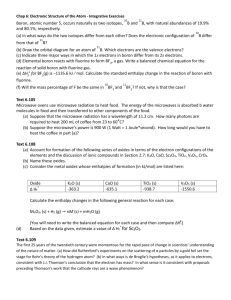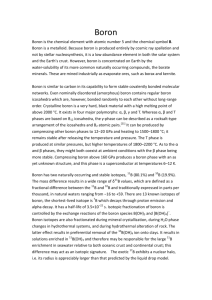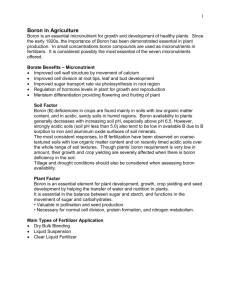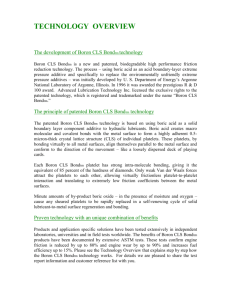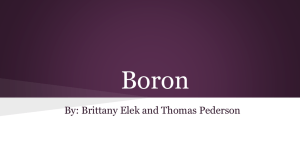Boron Analysis from Dietary Supplements
advertisement
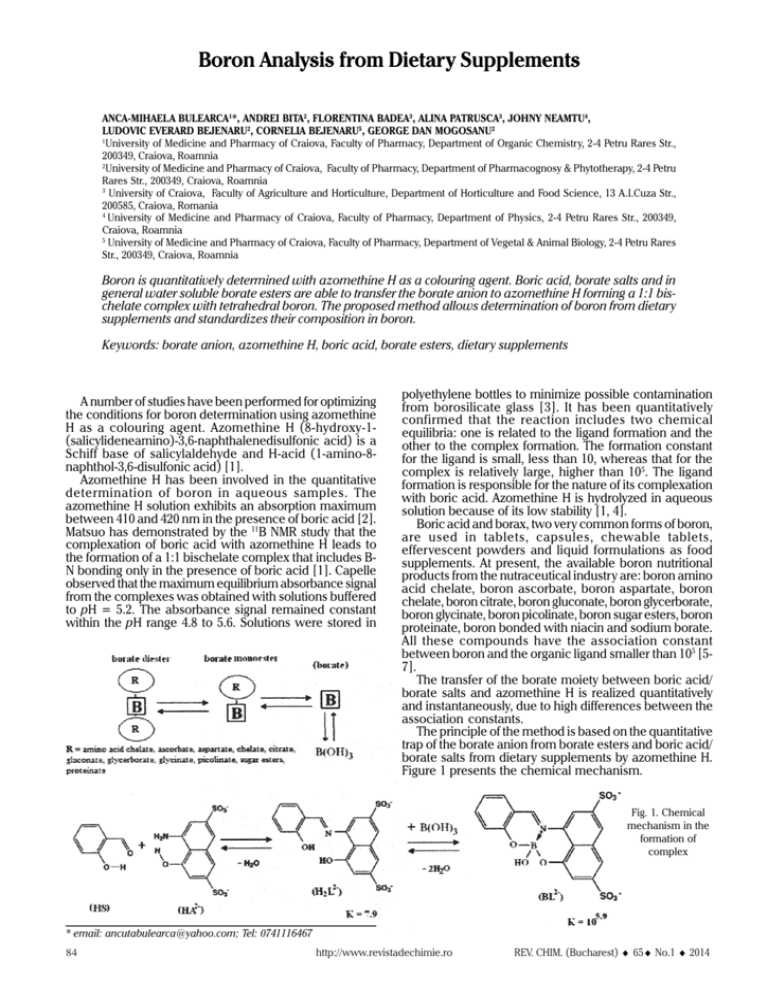
Boron Analysis from Dietary Supplements ANCA-MIHAELA BULEARCA1*, ANDREI BITA2, FLORENTINA BADEA3, ALINA PATRUSCA3, JOHNY NEAMTU4, LUDOVIC EVERARD BEJENARU2, CORNELIA BEJENARU5, GEORGE DAN MOGOSANU2 1 University of Medicine and Pharmacy of Craiova, Faculty of Pharmacy, Department of Organic Chemistry, 2-4 Petru Rares Str., 200349, Craiova, Roamnia 2 University of Medicine and Pharmacy of Craiova, Faculty of Pharmacy, Department of Pharmacognosy & Phytotherapy, 2-4 Petru Rares Str., 200349, Craiova, Roamnia 3 University of Craiova, Faculty of Agriculture and Horticulture, Department of Horticulture and Food Science, 13 A.I.Cuza Str., 200585, Craiova, Romania 4 University of Medicine and Pharmacy of Craiova, Faculty of Pharmacy, Department of Physics, 2-4 Petru Rares Str., 200349, Craiova, Roamnia 5 University of Medicine and Pharmacy of Craiova, Faculty of Pharmacy, Department of Vegetal & Animal Biology, 2-4 Petru Rares Str., 200349, Craiova, Roamnia Boron is quantitatively determined with azomethine H as a colouring agent. Boric acid, borate salts and in general water soluble borate esters are able to transfer the borate anion to azomethine H forming a 1:1 bischelate complex with tetrahedral boron. The proposed method allows determination of boron from dietary supplements and standardizes their composition in boron. Keywords: borate anion, azomethine H, boric acid, borate esters, dietary supplements A number of studies have been performed for optimizing the conditions for boron determination using azomethine H as a colouring agent. Azomethine H (8-hydroxy-1(salicylideneamino)-3,6-naphthalenedisulfonic acid) is a Schiff base of salicylaldehyde and H-acid (1-amino-8naphthol-3,6-disulfonic acid) [1]. Azomethine H has been involved in the quantitative determination of boron in aqueous samples. The azomethine H solution exhibits an absorption maximum between 410 and 420 nm in the presence of boric acid [2]. Matsuo has demonstrated by the 11B NMR study that the complexation of boric acid with azomethine H leads to the formation of a 1:1 bischelate complex that includes BN bonding only in the presence of boric acid [1]. Capelle observed that the maximum equilibrium absorbance signal from the complexes was obtained with solutions buffered to pH = 5.2. The absorbance signal remained constant within the pH range 4.8 to 5.6. Solutions were stored in polyethylene bottles to minimize possible contamination from borosilicate glass [3]. It has been quantitatively confirmed that the reaction includes two chemical equilibria: one is related to the ligand formation and the other to the complex formation. The formation constant for the ligand is small, less than 10, whereas that for the complex is relatively large, higher than 105. The ligand formation is responsible for the nature of its complexation with boric acid. Azomethine H is hydrolyzed in aqueous solution because of its low stability [1, 4]. Boric acid and borax, two very common forms of boron, are used in tablets, capsules, chewable tablets, effervescent powders and liquid formulations as food supplements. At present, the available boron nutritional products from the nutraceutical industry are: boron amino acid chelate, boron ascorbate, boron aspartate, boron chelate, boron citrate, boron gluconate, boron glycerborate, boron glycinate, boron picolinate, boron sugar esters, boron proteinate, boron bonded with niacin and sodium borate. All these compounds have the association constant between boron and the organic ligand smaller than 105 [57]. The transfer of the borate moiety between boric acid/ borate salts and azomethine H is realized quantitatively and instantaneously, due to high differences between the association constants. The principle of the method is based on the quantitative trap of the borate anion from borate esters and boric acid/ borate salts from dietary supplements by azomethine H. Figure 1 presents the chemical mechanism. Fig. 1. Chemical mechanism in the formation of complex * email: ancutabulearca@yahoo.com; Tel: 0741116467 84 http://www.revistadechimie.ro REV. CHIM. (Bucharest) ♦ 65♦ No.1 ♦ 2014 Experimental part Materials, methods and equipment Reagents Buffer masking solution. Dissolve 31.25 g of ammonium acetate (from Merck) and 1.875 g of ethylenedinitrilotetraacetic acid disodium salt (i.e., disodium ethylenediamine tetraacetate, EDTA disodium salt, reagent grade from Merck) in 50 mL of deionized distilled water (18.2 MΩ×cm). Add slowly 15.6 mL of glacial acetic acid (reagent grade from Merck). The solution pH is 5.3. Azomethine H reagent. Dissolve 0.2250 g of azomethine H (reagent grade from Merck) in 20-30 mL deionized distilled water (18.2 MΩ×cm) in a 50 mL volumetric flask. Add 0.5 g L-ascorbic acid (from Merck). Bring it to mark with deionized distilled water (18.2 MΩxcm). The solution pH is 2.5. Fresh reagent was prepared each week and stored in a refrigerator. Stock solution of Boric Acid. Dissolve 0.1143 g of boric acid (from Merck, 99.5% purity) in 1 (one) liter of deionized distilled water (18.2 MΩ×cm). Place the solution in a volumetric flask and bring it to mark with deionized distilled water. This solution contains 20 ppm boron. Standard solution containing 0.5, 1, 2, 4 and 8 ppm boron were prepared by diluting this stock solution of boric acid with deionized distilled water. Due to the fact that the working boric acid has a purity of 99.5%, the content in boron was corrected. Thus, standards contain 0.498, 0.995, 1.990, 3.980 and 7.960 ppm boron. Stock solution of calcium ascorbatoborate complex. Dissolve 0.3076 g of calcium ascorbatoborate complex synthesized in accordance with [7] in 1 (one) liter of deionized distilled water (18.2 MΩ×cm). Place the solution in a volumetric flask and bring it to mark with deionized distilled water. This solution contains 307.6 ppm calcium ascorbatoborate complex. From this standard solution prepare other 4 standards, namely 153.8, 76.9, 38.5 and 19.2 ppm content in calcium ascorbatoborate complex, by dilution with deionized distilled water. Equipment UV-VIS spectrophotometer, T70+ model, from PG Instruments, England. This spectrophotometer adequate for molecular absorption is fixed at a wavelength of 415 nm and equipped with quartz cuvettes having the optical path of 10 mm. Thermostated water bath, DIGIBATH-2 BAD-4 model, from Spain. TKA Lab Tower system for pure water, EDI 15 model, at 250C the resistivity is 18.2 MΩ×cm, from Germany. High-Resolution Continuum Source Atomic Absorption Spectrometer for Flame (HRCS-AAS), contrAA® model, equipped with a 50 mm burner head and a scraper, Germany. Results and discussions Determination of calibration curve for boric acid With a very high accuracy take 1 mL from each standard solution having the content in boron specified above and pipette into 10 mL polypropylene tube. Exactly 2 mL of buffer masking solution are added in each tube. The contents of the tube were mixed. Exactly 2 mL of azomethine H solution are poured over the mixture from each tube. The reaction mixture was again stirred. A blank sample is prepared with 1 mL of deionized distilled water (18.2 MΩ x cm), 2 mL of buffer masking solution and 2 mL of azomethine H solution. The pH of the final mixture solutions is 5.0±0.2. Place the tubes with solutions at dark, at a constant temperature, and allow them to stand for a certain period of time. The working temperature is 23 ± 0.5 o C and it should be maintained constant with a thermostated water bath. After 30 min, samples are analyzed on the UV-Vis spectrophotometer. Thus, the calibration curve of boron from boric acid is generated after 30 min, at a wavelength of 415 nm (fig. 2). Fig.2. Calibration curve of boric acid at 30 minutes (R^2 = 0.9999; slope = 0.15275) Table 1 CONCENTRATIONS OF BORON OBTAINED FROM NUTRACEUTICAL SAMPLES AND FROM CALCIUM ASCORBATOBORATE COMPLEX STANDARD RAW MATERIAL AT 30 MIN REV. CHIM. (Bucharest) ♦ 65 ♦ No. 1 ♦ 2014 http://www.revistadechimie.ro 85 Table 2 CONCENTRATION OF BORON FROM EACH CAPSULE OF NUTRACEUTICAL AND FROM CALCIUM ASCORBATOBORATE COMPLEX STANDARD RAW MATERIAL Determination of boron from calcium ascorbatoborate complex Take with a very high accuracy 1 mL from each calcium ascorbatoborate complex standard sample prepared above and pipette into 10 mL polypropylene tube. Repeat the procedure and the working conditions described above for boric acid. The calcium ascorbatoborate complex sample is analyzed on the UV-VIS spectrophotometer, on the calibration curve of boric acid generated at 30 min, at a wavelength of 415 nm. Determination of boron from some dietary supplements found on the national market Azomethine H method Three samples of nutraceuticals were analyzed. Their commercial names are VitaCab, Organic Boron and Osteoremed. These products have the following compositions in boron (table 1). In addition, table 1 gives the concentration of boron from calcium ascorbatoborate complex standard raw material. High-Resolution Continuum-Source AAS flame technique Furthermore, the three nutraceutical samples were analyzed by High-Resolution Continuum-Source AAS flame technique. For sample preparation, the content of one pill (each approximately 0.20-0.28 g) is digested at 2000C in a mixture of nitric acid and hydrogen peroxide using the microwave digestion system TOPwave. After digestion, it is transferred into a 25 mL volumetric flask and filled up with deionized water. Then, it is diluted with 0.1% CsCl/ LaCl3, depending on the concentration range. The results are given in table 2. Azomethine H method versus High-Resolution ContinuumSource AAS flame technique As it is observed from tables 1 and 2, the percentage of boron from the nutraceutical samples is almost the same by both methods, with azomethine H and by HRCS-AAS flame. This fact ensures the correctness of the colorimetric method with azomethine H for boron determination. Conclusions This paper proposes a colorimetric method with azomethine H for analyzing boron from dietar y supplements. The method is based on the azomethine H capability to quantitatively trap the borate anion from boric acid/borate salts and borate esters from dietar y supplements. The suggested procedure is rather simple, less expensive, does not require performant equipment, nor degradation or digestion of the sample to be analyzed. This method with azomethine H allows the determination of boron amount from different samples, including dietary supplements. In addition, boron from borate esters nutraceuticals can be very easily analyzed. Moreover, the procedure is able to standardize the composition in boron for each batch of nutraceuticals. Thus, it can be a method of control for the boron stream and it can be realized at a continuous flux. In the presence of boron, the azomethine H solution exhibits an absorption maximum at a wavelength of 415 nm. Only 30 min is enough time for the absorbance to reach a stable maximum. The optimum working temperature is 23±0.5 0C, maintained by a thermostated water bath in which the sample for analysis is kept in dark. The proper pH for the solution sample is 5.0±0.2. Thus, the method is strongly influenced by time, temperature and pH. This proposed method with azomethine H was verified on three different nutraceuticals, namely VitaCab, Organic Boron and Osteoremed, and the results were similar to those obtained by High-Resolution Continuum-Source AAS flame technique. Acknowledgments: To Analytik Jena AG, Konrad-Zuse-Straße 1, 07745 Jena, Germany, for the support in the analysis of nutraceuticals by High-Resolution Continuum-Source AAS flame technique. References 1. MATSUO, H., MIYAZAKI, Y., TAKEMURA, H., MATSUOKA, S., SAKASHITA, H., YOSHIMURA, K., Polyhedron, 23, 2004, p. 955. 2. JOHN, M.K., CHUAH, H.H., NEUFELD, J.H., Anal. Lett., 8, no. 8, 1975, p. 559. 3. CAPELLE, R., Anal. Chim. Acta, 24, 1961, p. 555. 4. MCDANIEL, D.M., Chemical analysis for boron in nuclear reactor coolant water. Thesis for the degree of Master of Science, Oregon State University, 1984. 5. HUNT, C.D., Encyclop. Diet. Suppl. 2nd Ed. New York, London: Informa Healthcare, 2010, p. 82. 6. DINCA, L., SCOREI, R., J. Nutr. Ther., 2, no. 1, 2013, p. 22. 7. DURSUN, A.K., BIRGUL, Z.-K., New J. Chem., 33, 2009, p. 1874 Manuscript received: 8.04.2013 86 http://www.revistadechimie.ro REV. CHIM. (Bucharest) ♦ 65♦ No.1 ♦ 2014

